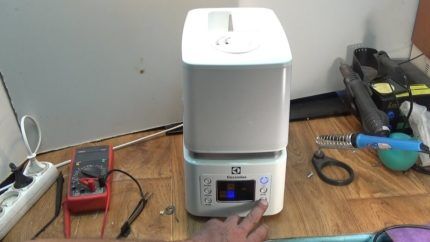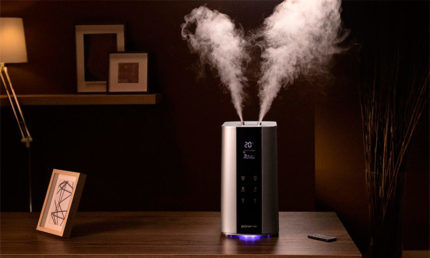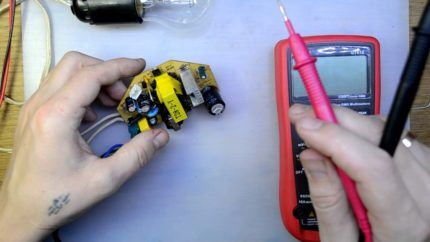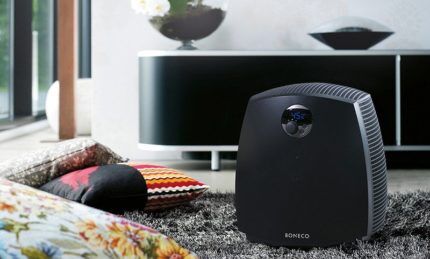Humidifier errors: popular humidifier breakdowns and recommendations for their repair
The smooth operation of the air humidifier is ensured by complex mechanisms and electronic programs.And, like any other equipment, these devices require proper handling and timely maintenance. But even if all operational requirements are met, the device may fail.
This article contains information about the most common humidifier errors and how to fix most problems yourself. Recommendations for the repair of steam, ultrasonic and traditional cold-type humidifiers are provided. The material is supplemented with visual photos and thematic videos.
The content of the article:
Signs of broken humidifiers
Even during proper use of the humidifier Various problems may arise. Thus, users may most often encounter the following: no steam from the humidifier.
If this is an ultrasonic type device, then, first of all, you should make sure that the membrane is located under water. Another possible reason for such a breakdown is clogging of the membrane. For preventative purposes, you can wipe the part with a weak solution of vinegar. The steam flow also reflects the performance of the turbine and generator.
Other popular problems that humidifier owners encounter:
- The amount of water in the tank does not decrease if the integrity of the membrane or the device responsible for its movement is violated.
- Reduced or no air flow in operating mode due to clogged air intake filters and tubes. Equipment may also fail due to fan failure.
- Windows fog up in a room with the device running, wet pollen appears on the furniture, and the sensor shows a normal value, this indicates a malfunction of the equipment. The optimal level of air humidity is no more than 60%.
- The steam has an unpleasant odor. The reason may be clogging of the membrane, the spread of mold and mildew inside the device itself. You may also need to urgently replace the filters.
- There is no sound signal, the timer and sensors are inactive. All this indicates failure of the electronics. Also, the liquid crystal screen will not work in this case.
- It's getting harder to breathe indoors when the device has exceeded the permissible humidity value. This means that the humidity sensor does not work.
- The humidifier continues to operate when the water level is extremely low, although it should turn off automatically. This condition also applies to programming the timer if the device continues to operate after the set time has elapsed. In this case, the equipment must be disconnected from the electrical network.
- Significant increase in case temperature indicates it is overheating.
Indicates a breakdown of the electric motor or ventilation system. increased noise from the operation of the humidifier.

When a characteristic burning smell the device must be disconnected immediately. Appearance of smoke - a sign of a serious malfunction of an electrical appliance that must be immediately disconnected from the network.
Reasons for lack of steam and solutions
Lack of steam is one of the most common faults that occurs in all types of humidifiers. Therefore, we will analyze in more detail the reasons for such a breakdown for each types of devices, and also talk about ways to eliminate it.
Diagnostics should begin by checking the outlet, the indicator of the electrical device and the presence of water in the tank. But keep in mind that any repair work is carried out only after disconnecting the humidifier from the network.
Cold type devices
So-called traditional humidifiers may stop generating steam for several reasons:
- Worn filters - In this case, the parts should be replaced with new ones.
- Engine malfunction. The unit is responsible for the operation of the turbine and fan. It cannot be repaired, the motor can only be replaced.
- Raid. If you hear the sound of an engine when you turn on the humidifier, but the turbine impeller and cooler remain motionless, the reason may be limescale, which should be removed. Failure can also be determined by the direction of the steam, which will spread below, and not exit vertically upward.
Lack of steam can also be caused by damage to wires, which often happens when transporting the device.

Ultrasonic humidifiers
The key element of an ultrasonic humidifier is a membrane or disk (emitter, piezoelectric element) and a low-power fan. The membrane begins to vibrate when alternating current is applied at an ultrasonic frequency, causing the water to break into tiny particles, and the built-in fan pushes them into the room.
Often this type of humidifier produces insufficient steam or no steam at all due to a faulty electromechanical converter. It will not be possible to fix the breakdown on your own; the part must be replaced. A membrane malfunction can be determined by the absence of the characteristic sound of bubbling water.

If the humidifier was put into operation without water, the membrane and then the transistor fail. Prolonged operation in this mode can damage other elements of the generator board, which will lead to damage to the power supply.
Another reason for the malfunction of an ultrasonic humidifier is contamination or damage to the membrane, as well as failure of the mechanism that makes it vibrate (ultrasonic vibration generation boards). The problem can be fixed by cleaning the membrane; it may also be necessary to replace the entire device that drives the transducer.
It is also worth cleaning the membrane if too little steam is generated from the humidifier. This can be done using any descaling cleaning products. Vinegar solution and citric acid will also help. The product should be poured into the recess with the membrane and wait until the scale is completely dissolved.Too thick a layer of plaque can be removed with an old toothbrush. Using abrasives or metal objects will damage the membrane.
Steam device failure
These humidifiers often do not produce steam due to a faulty heating element. If the water does not heat up when the device is turned on, the heating element will need to be replaced.
Lack of steam may be due to failure of the impeller, motor, wiring and fan, as is the case with cold-type devices.

There is another type of humidifier - spray, but its repair should be carried out exclusively by specialists. Interfering with the operation of an expensive device can cause harm.
Step-by-step DIY repair instructions
You can clean the membrane and other parts from scale and replace filters yourself. Repair of components, including the system board, is best left to professionals. Interfering with the structure can complicate the situation.
To carry out repairs at home, you will need basic electrical knowledge, a multimeter, a tester and soldering skills.
Next, we will look at the step-by-step process of repairing a household ultrasonic humidifier.
Stage #1 - disassembling the humidifier
To find out the cause of the breakdown, it is necessary to disassemble the device, having previously de-energized it.
Before removing the tank, you should prepare a special bowl for the liquid. Remaining moisture in the tray can be removed with a dry cloth. Under the remaining part of the body there are bolts - from 3 to 5 pieces.By unscrewing them, you can remove the bottom cover.

If the humidifier has a built-in hygrometer, it is important to avoid sudden movements, as the contacts and wires of the device can be damaged. As a rule, it is mounted near the ventilation grille - on the inside of the bottom cover.
Stage #2 - diagnostics of the device
With the device disassembled, you can carry out several simple tests to eliminate possible breakdowns. To do this, connect the humidifier to the network and check the operation of the cooler or fan.
After two minutes of operation and after unplugging from the outlet, you can determine the temperature of the transistor by touch. If it is cold, this indicates a faulty generator.

Damage to the emitter can be determined by the absence of sounds from the membrane; in this case, the part must be replaced. All that remains is to ring all the contacts on the board using a multimeter.
If all of the above malfunctions are not confirmed, the reason for the non-working humidifier may be a simple clogged cartridge. This can be avoided by timely replacement of filters.
Stage #3 - cleaning the structure
In addition to replacing filters, maintenance also includes rinsing the container with running water and wiping the inside with a soft brush or rag.
It is prohibited to use aggressive chemicals, including dishwashing liquid or toilet bowl cleaning gels. Not only the parts of the humidifier, but also the entire household may be affected. After all, the remaining particles of the substance on the walls will enter the air when the device is subsequently started.

Safe use of a humidifier also involves disinfection; this is no longer ordinary cleaning, but getting rid of accumulated microorganisms. For this purpose, acetic acid, chlorine bleach and hydrogen peroxide are used.
The latter substance is used in its pure form. The bleach is diluted with water, and the acid is adjusted to a concentration of 10 to 20%. The resulting mixture is poured into a container and kept for several hours. After the procedure, it is important to thoroughly rinse the humidifier and wipe it with a soft cloth.
We have provided detailed recommendations and the best methods for cleaning humidifiers in this article.
Stage #4 - troubleshooting in the electronic part
You can determine if the board is broken even by visual inspection.
If it is working properly, it should have the following properties:
- evenly colored;
- there are no smudges or stains on the surface;
- all contacts, without exception, are soldered and dialed;
- there are no swollen elements;
- there are no darkened resistors (a change in shade indicates combustion of the part).
It is also important to check for breakdowns in the board tracks.

A short circuit can damage the fuses and will require re-soldering. To remove the board from the socket, unscrew the bolts and then clean the surface with a soft brush and alcohol.
Stage #5 - replacing the ultrasonic membrane
We discussed above how to determine a membrane malfunction.
The process of replacing it includes several stages:
- it is necessary to unscrew the mounting bolts;
- then remove the ceramic ring with part of the board;
- the round membrane is attached to the board with a pair of wires, which should be carefully desoldered;
- The process is completed by soldering the wires of the new piezoelectric element into the board.
When replacing the membrane, it is advisable to immediately replace the high-frequency transistor, choosing a spare part that meets factory requirements. Differences in characteristics may hinder the steam generation process.
Tips for using the device
The following tips will help protect your humidifier from damage:
- Water must be poured directly into the hole provided for this purpose by the manufacturer.
- It is prohibited to use the steam nozzle for inhalation; for some models, the manufacturer provides a special nozzle for this purpose.
- Vinegar should be used to clean equipment only in fresh air, otherwise it may burn the mucous membrane of the respiratory tract.
- It is not recommended to place the device near electrical devices.
- Before disconnecting the humidifier from the mains, you must not disassemble it or touch the internal parts with your hands.
- Do not touch the humidifier body with wet hands.
- Damaged items should be disposed of in the manner specified by the manufacturer in the safety regulations.
It is also important to remember that during operation the device cannot be covered from above; there must be access to oxygen in the lower part, where air is directly taken in.

A few simple tips will also help extend the life of your humidifier:
- If the device does not have a filter built-in, it is advisable to use boiled, distilled or pre-filtered water. We will tell you in detail what kind of water to pour into the humidifier. told here.
- Twice a month it is advisable to disinfect the components with a vinegar solution. The water should be changed daily to help prevent mold.
- Modern models are equipped with a notification function about the need to clean and replace filters. Replacement parts must be of the same brand as the device itself. We recommend that you read rating of the best models.
- The humidifier should be installed on a perfectly flat surface. Free air access is also important for smooth operation. It is not recommended to lean the equipment against the wall, leave it near furniture or under the bed.
- Do not leave the device in a room with small children unattended. There are known cases when the humidifier was pushed or covered with a blanket on top; small parts also got into the air intake slots.
If the equipment is used only during the heating season, then before storing it, it is necessary to treat the tubes and membranes with hydrogen peroxide. Then disassemble and dry all the parts. Keep in original, closed packaging, away from direct sunlight.
It is prohibited to add essential oils to a humidifier that is not intended for aromatherapy. Otherwise, components may quickly fail.
Conclusions and useful video on the topic
The solution to the problem of lack of steam in a humidifier is discussed in detail in the story:
Step-by-step instructions for checking piezoelements for humidifiers can be viewed in the following video:
How to repair an ultrasonic humidifier at home:
In most cases, you can repair the humidifier yourself. It is much more difficult to detect the real cause of the malfunction. In some situations, it is quite difficult to do this without special devices, so it is better to turn to specialists. Proper operation of the equipment, timely replacement of filters, cleaning and disinfection will help to avoid serious damage.
If you have encountered problems with your humidifier, please share your experience. The block for comments and questions is below the text - here you can ask questions to our experts and other users about the poor performance of the device and possible breakdowns.




Hello.
The humidifier recently broke after working for a year. An acquaintance who repairs all kinds of equipment didn’t even watch it. Allegedly, repairs will cost more than a new device. It's a shame, damn it. So, should I buy a new one every six months? Where is this one going? However, I digress.
After another wash, when I tried to turn it on, a bang was heard and the device stopped showing signs of life. My husband took it apart to look and said that it was because I washed it incorrectly and poured water inside. Although, I know that I didn’t flood it. I always covered the hole above the fan with my finger.
Tell me, is this the END? What should I do? The ultrasonic humidifier was good and worked flawlessly.
Of course, I can’t fix it myself, and you won’t find the Kulibins during the day... It’s just a disaster...
Olesya, don’t worry - most likely moisture really got in (it couldn’t have been because of you!); I restore such devices - almost every week 2-3 units arrive..
Moisture enters the temperature sensor.
Help with repair advice.
So that she could do it herself.
Hello! I bought a humidifier, the first hours worked flawlessly, but after 4 hours it leaked between the base and the tank. They drained the water, checked everything, turned it on again - same problem. In the afternoon I tried to turn it on again and started watching it, after a couple of hours the first drop appeared. I drained the water, the base overflowed again due to the fact that the float that regulates the flow of water lies at the bottom. I lifted the float with my finger, it seemed to float, but almost immediately sank. What to do? I can't find similar problems on the Internet.
Olesya, don’t worry - most likely moisture really got in (it couldn’t have been because of you!); I restore such devices - almost every week 2-3 units arrive..
Natalia,
You need to make sure that the float does not float when you add water. Remove the water container and try pouring it directly into the pan. If it really doesn't pop up, the device won't work.There is something wrong with the float itself. But this was extremely rare in my practice. At the same time, if you lift the float by hand, secure it in the raised state and the device starts working, then the breakdown is obvious - you need to change the hyrcon sensor. This is a simple procedure.
wetair mh2028
As it was unnecessary, the humidifier did not turn on for a month and stood without water. The float has stopped floating, and therefore the retractor switch does not turn on. What affects the buoyancy of a float?
Humidifier operating life 1.5 years
We bought an air humidifier, all the functions work as expected, it shows humidity, but for some reason it doesn’t show the temperature, just zero lights, what’s the problem?
Yulia, most likely the contacts of the temperature sensor are bad: on the board they are often poorly soldered and come off..
I replaced the piezo element in the humidifier myself, it started working, everything is fine. After a very short time (about 15 minutes), I turned it off, added water, moved it to another place, turned it on, but it didn’t even turn on. The indicators do not light up. The transformer on the power supply makes characteristic clicks and that’s it. What to do, please tell me.
I poured water into the humidifier. When you turn it on, steam comes out for a second, then it says not enough water and stops working, but there is water in it. What is the reason?
Similar problem. I hear the hum of the engine, which raises the valve, but it does not rise. Really, marriage?
Hello! Tell me, who knows, I have encountered a problem: the Xiaomi Deerma DEM-F500 air humidifier has stopped lighting with an even light, i.e. When I turn it on, the backlight blinks and no steam comes out? What could it be?
I poured water into the humidifier, plugged it in, and the indicator light was red, as if there was no water. Although it is there... What could be the reason?
The humidifier works all day, my glasses fog up on my nose, and it shows humidity of 28-30%
Good afternoon. Sorry for delay. Fogging is related to three indicators: air temperature, humidity and pressure. Water is always present in the air in the form of water vapor. As soon as the concentration of the latter reaches a certain value, dew falls, also known as condensation. But water vapor can condense only under certain conditions.
For example, one cubic meter of air at a temperature of +16C contains 13.6 g of water. If the humidity of the air increases, that is, the water content in it increases, this leads to the appearance of a large number of water droplets. At a temperature of +9C, the humidity will decrease - the amount of water will already be 9.4 g.
Good afternoon. Tell me, please, we bought a Deerma DEM-F628s humidifier, the first thing we did was increase the size of the aroma oil tray, and then the plastic started melting in this place, and eventually burst. The question is, is this case covered by warranty? If not, is there any way to fix the tank?
Good afternoon. You should contact the seller and file a warranty claim.
Hello. The Polaris humidifier (as in the first picture) heats up the water in the container, in which direction should I dig?
I washed the humidifier and poured water, it works but it constantly beeps, and all the information on the display changes itself, what is this?
Shows air humidity 95% what is the reason, the new one was turned on for the first time and it immediately shows like that